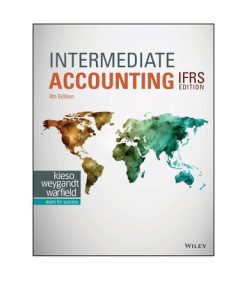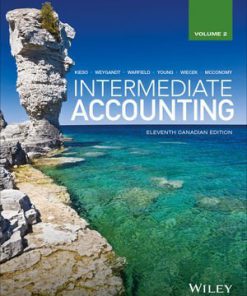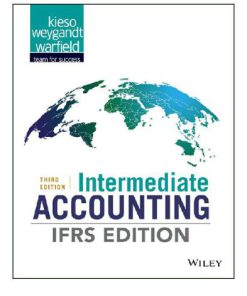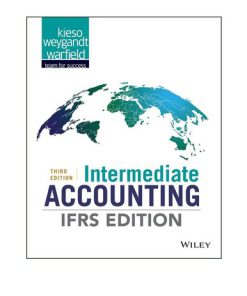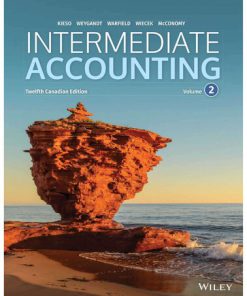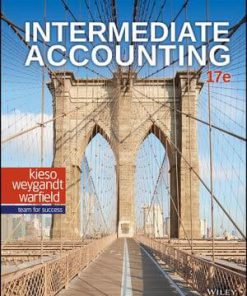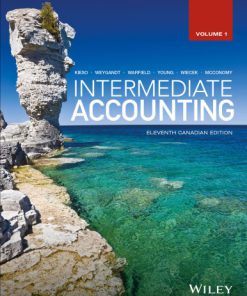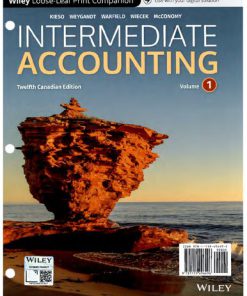Intermediate Accounting 16th Edition by Donald Kieso, Jerry Weygandt, Terry Warfield 1119175117 9781119175117
$50.00 Original price was: $50.00.$25.00Current price is: $25.00.
Intermediate Accounting 16th Edition by Donald E. Kieso, Jerry J. Weygandt, Terry D. Warfield – Ebook PDF Instant Download/DeliveryISBN: 1119175117, 9781119175117
Full download Intermediate Accounting 16th Edition after payment.

Product details:
ISBN-10 : 1119175117
ISBN-13 : 9781119175117
Author: Donald E. Kieso, Jerry J. Weygandt, Terry D. Warfield
Kieso, Weygandt, and Warfield’s Intermediate Accounting continues to set the standard for students and professionals in the field. The 16th edition builds on this legacy through new, innovative student-focused learning. Kieso maintains the qualities for which the text is globally recognized, including its reputation for accuracy, comprehensiveness, accessibility, and quality problem material that best prepares students for success on the CPA exam and accounting careers. The 16th edition offers the most up-to-date coverage of US GAAP & IFRS in a presentational format suited to the complex challenges of teaching intermediate accounting in these changing times.
Intermediate Accounting 16th Table of contents:
1 Financial Accounting and Accounting Standards
WE CAN DO BETTER
FINANCIAL REPORTING ENVIRONMENT
Accounting and Capital Allocation
What Do the Numbers Mean? It’s the Accounting
Objective of Financial Reporting
What Do the Numbers Mean? Don’t Forget Stewardship
The Need to Develop Standards
PARTIES INVOLVED IN STANDARD-SETTING
Securities and Exchange Commission (SEC)
American Institute of Certified Public Accountants (AICPA)
Financial Accounting Standards Board (FASB)
GENERALLY ACCEPTED ACCOUNTING PRINCIPLES
What Do the Numbers Mean? You Have to Step Back
FASB Codification
MAJOR CHALLENGES IN FINANCIAL REPORTING
GAAP in a Political Environment
Evolving Issue Fair Value, Fair Consequences?
The Expectations Gap
Financial Reporting Issues
International Accounting Standards
What Do the Numbers Mean? Can You Do That?
Ethics in the Environment of Financial Accounting
Conclusion
IFRS INSIGHTS
2 Conceptual Framework for Financial Reporting
WHAT IS IT?
CONCEPTUAL FRAMEWORK
Need for a Conceptual Framework
What Do the Numbers Mean? What’s Your Principle?
Development of a Conceptual Framework
Overview of the Conceptual Framework
FIRST LEVEL: BASIC OBJECTIVE
SECOND LEVEL: FUNDAMENTAL CONCEPTS
Qualitative Characteristics of Accounting Information
What Do the Numbers Mean? Living in a Material World
What Do the Numbers Mean? Show Me the Earnings!
Basic Elements
THIRD LEVEL: RECOGNITION AND MEASUREMENT CONCEPTS
Basic Assumptions
What Do the Numbers Mean? Whose Company Is It?
Basic Principles of Accounting
Cost Constraint
Summary of the Structure
What Do the Numbers Mean? Don’t Count These Please
FASB CODIFICATION
IFRS INSIGHTS
3 The Accounting Information System
NEEDED: A RELIABLE INFORMATION SYSTEM
ACCOUNTING INFORMATION SYSTEM
Basic Terminology
Debits and Credits
The Accounting Equation
Financial Statements and Ownership Structure
The Accounting Cycle
RECORD AND SUMMARIZE BASIC TRANSACTIONS
Journalizing
Posting
Trial Balance
ADJUSTING ENTRIES
Types of Adjusting Entries
Adjusting Entries for Deferrals
Adjusting Entries for Accruals
What Do the Numbers Mean? Am I Covered?
Adjusted Trial Balance
PREPARING FINANCIAL STATEMENTS
What Do the Numbers Mean? 24/7 Accounting
Closing
Post-Closing Trial Balance
Reversing Entries—An Optional Step
The Accounting Cycle Summarized
What Do the Numbers Mean? Hey, It’s Complicated
FINANCIAL STATEMENTS FOR A MERCHANDISING COMPANY
Income Statement
Statement of Retained Earnings
Balance Sheet
What Do the Numbers Mean? Statements, Please
Closing Entries
APPENDIX 3A: CASH-BASIS ACCOUNTING VERSUS ACCRUAL-BASIS ACCOUNTING
CONVERSION FROM CASH BASIS TO ACCRUAL BASIS
Service Revenue Computation
Operating Expense Computation
THEORETICAL WEAKNESSES OF THE CASH BASIS
APPENDIX 3B: USING REVERSING ENTRIES
ILLUSTRATION OF REVERSING ENTRIES—ACCRUALS
ILLUSTRATION OF REVERSING ENTRIES—DEFERRALS
SUMMARY OF REVERSING ENTRIES
APPENDIX 3C: USING A WORKSHEET: THE ACCOUNTING CYCLE REVISITED
WORKSHEET COLUMNS
Trial Balance Columns
Adjustments Columns
ADJUSTMENTS ENTERED ON THE WORKSHEET
Adjusted Trial Balance
Income Statement and Balance Sheet Columns
PREPARING FINANCIAL STATEMENTS FROM A WORKSHEET
IFRS INSIGHTS
4 Income Statement and Related Information
FINANCIAL STATEMENTS ARE CHANGING
INCOME STATEMENT
Usefulness of the Income Statement
Limitations of the Income Statement
Quality of Earnings
What Do the Numbers Mean? Four: The Loneliest Number
FORMAT OF THE INCOME STATEMENT
Elements of the Income Statement
Intermediate Components of the Income Statement
What Do the Numbers Mean? Top Line or Bottom Line?
Condensed Income Statements
Single-Step Income Statements
REPORTING VARIOUS INCOME ITEMS
Unusual and Infrequent Gains and Losses
Discontinued Operations
Noncontrolling Interest
Earnings per Share
Summary of Various Income Items
What Do the Numbers Mean? Different Income Concepts
OTHER REPORTING ISSUES
Accounting Changes and Errors
Retained Earnings Statement
Comprehensive Income
Evolving Issue Income Reporting
FASB CODIFICATION
IFRS INSIGHTS
5 Balance Sheet and Statement of Cash Flows
HEY, IT DOESN’T BALANCE!
BALANCE SHEET
Usefulness of the Balance Sheet
Limitations of the Balance Sheet
What Do the Numbers Mean? Grounded
Classification in the Balance Sheet
What Do the Numbers Mean? “Show Me the Assets!”
What Do the Numbers Mean? Warning Signals
Balance Sheet Format
STATEMENT OF CASH FLOWS
What Do the Numbers Mean? Watch That Cash Flow
Purpose of the Statement of Cash Flows
Content and Format of the Statement of Cash Flows
Preparation of the Statement of Cash Flows
Usefulness of the Statement of Cash Flows
What Do the Numbers Mean? “There Ought to Be a Law”
ADDITIONAL INFORMATION
Supplemental Disclosures
What Do the Numbers Mean? What About Your Commitments?
Techniques of Disclosure
Evolving Issue Balance Sheet Reporting: Gross or Net?
APPENDIX 5A: RATIO ANALYSIS—A REFERENCE
USING RATIOS TO ANALYZE PERFORMANCE
FASB CODIFICATION
IFRS INSIGHTS
6 Accounting and the Time Value of Money
HOW DO I MEASURE THAT?
BASIC TIME VALUE CONCEPTS
Applications of Time Value Concepts
The Nature of Interest
Simple Interest
Compound Interest
What Do the Numbers Mean? A Pretty Good Start
Fundamental Variables
SINGLE-SUM PROBLEMS
Future Value of a Single Sum
Present Value of a Single Sum
Solving for Other Unknowns in Single-Sum Problems
ANNUITIES (FUTURE VALUE)
Future Value of an Ordinary Annuity
Future Value of an Annuity Due
What Do the Numbers Mean? Don’t Wait to Make That Contribution!
Examples of Future Value of Annuity Problems
ANNUITIES (PRESENT VALUE)
Present Value of an Ordinary Annuity
What Do the Numbers Mean? Up in Smoke
Present Value of an Annuity Due
Examples of Present Value of Annuity Problems
OTHER TIME VALUE OF MONEY ISSUES
Deferred Annuities
Valuation of Long-Term Bonds
Effective-Interest Method of Amortization of Bond Discount or Premium
Present Value Measurement
What Do the Numbers Mean? How Low Can They Go?
FASB CODIFICATION
7 Cash and Receivables
LUCK OF THE IRISH
CASH
Reporting Cash
Summary of Cash-Related Items
What Do the Numbers Mean? Where Did I Park My Cash?
RECEIVABLES
Recognition of Accounts Receivable
Valuation of Accounts Receivable
NOTES RECEIVABLE
Recognition of Notes Receivable
Valuation of Notes Receivable
What Do the Numbers Mean? Please Release Me?
SPECIAL ISSUES
Fair Value Option
Disposition of Accounts and Notes Receivable
What Do the Numbers Mean? Securitizations—Good or Bad?
Presentation and Analysis
What Do the Numbers Mean? I’m Still Waiting
APPENDIX 7A: CASH CONTROLS
USING BANK ACCOUNTS
THE IMPREST PETTY CASH SYSTEM
PHYSICAL PROTECTION OF CASH BALANCES
RECONCILIATION OF BANK BALANCES
APPENDIX 7B: COLLECTABILITY ASSESSMENT BASED ON EXPECTED CASH FLOWS
MEASUREMENT OF COLLECTIBILITY
Example
Recording Bad Debts
FASB CODIFICATION
IFRS INSIGHTS
8 Valuation of Inventories: A Cost-Basis Approach
TO SWITCH OR NOT TO SWITCH
INVENTORY ISSUES
Classification
Inventory Cost Flow
Inventory Control
What Do the Numbers Mean? Staying Lean
Determining Cost of Goods Sold
GOODS AND COSTS INCLUDED IN INVENTORY
Goods Included in Inventory
What Do the Numbers Mean? No Parking!
Costs Included in Inventory
What Do the Numbers Mean? You May Need a Map
WHICH COST FLOW ASSUMPTION TO ADOPT?
Specific Identification
Average-Cost
First-In, First-Out (FIFO)
Last-In, First-Out (LIFO)
SPECIAL ISSUES RELATED TO LIFO
LIFO Reserve
What Do the Numbers Mean? Comparing Apples to Apples
LIFO Liquidation
Dollar-Value LIFO
What Do the Numbers Mean? Quite a Difference
Comparison of LIFO Approaches
Major Advantages of LIFO
Major Disadvantages of LIFO
Basis for Selection of Inventory Method
Evolving Issue Repeal LIFO!
EFFECT OF INVENTORY ERRORS
Ending Inventory Misstated
Purchases and Inventory Misstated
FASB CODIFICATION
9 Inventories: Additional Valuation Issues
NOT WHAT IT SEEMS TO BE
LOWER-OF-COST-OR-NET REALIZABLE VALUE
Definition of Net Realizable Value
Illustration of LCNRV
Methods of Applying LCNRV
Recording NRV Instead of Cost
Use of an Allowance
Use of an Allowance—Multiple Periods
LOWER-OF-COST-OR-MARKET
How Lower-of-Cost-or-Market Works
Methods of Applying Lower-of-Cost-or-Market
What Do the Numbers Mean? “Put It in Reverse”
Evaluation of the LCNRV and Lower-of-Cost-or-Market Rules
OTHER VALUATION APPROACHES
Valuation at Net Realizable Value
Valuation Using Relative Sales Value
Purchase Commitments—A Special Problem
THE GROSS PROFIT METHOD OF ESTIMATING INVENTORY
Computation of Gross Profit Percentage
Evaluation of Gross Profit Method
What Do the Numbers Mean? The Squeeze
RETAIL INVENTORY METHOD
Retail-Method Concepts
Retail Inventory Method with Markups and Markdowns—Conventional Method
What Do the Numbers Mean? Price Fixing
Special Items Relating to Retail Method
Evaluation of Retail Inventory Method
PRESENTATION AND ANALYSIS
Presentation of Inventories
Analysis of Inventories
APPENDIX 9A: LIFO RETAIL METHODS
STABLE PRICES—LIFO RETAIL METHOD
FLUCTUATING PRICES—DOLLAR-VALUE LIFO RETAIL METHOD
SUBSEQUENT ADJUSTMENTS UNDER DOLLAR-VALUE LIFO RETAIL
CHANGING FROM CONVENTIONAL RETAIL TO LIFO
FASB CODIFICATION
IFRS INSIGHTS
10 Acquisition and Disposition of Property, Plant, and Equipment
WATCH YOUR SPENDING
PROPERTY, PLANT, AND EQUIPMENT
Acquisition of Property, Plant, and Equipment
Self-Constructed Assets
Interest Costs During Construction
What Do the Numbers Mean? What’s in Your Interest?
Observations
VALUATION OF PROPERTY, PLANT, AND EQUIPMENT
Cash Discounts
Deferred-Payment Contracts
Lump-Sum Purchases
Issuance of Stock
Exchanges of Nonmonetary Assets
What Do the Numbers Mean? About Those Swaps
Accounting for Contributions
Other Asset Valuation Methods
COSTS SUBSEQUENT TO ACQUISITION
What Do the Numbers Mean? Disconnected
Additions
Improvements and Replacements
Rearrangement and Reinstallation
Repairs
Summary of Costs Subsequent to Acquisition
DISPOSITION OF PROPERTY, PLANT, AND EQUIPMENT
Sale of Plant Assets
Involuntary Conversion
Miscellaneous Problems
FASB CODIFICATION
11 Depreciation, Impairments, and Depletion
HERE COME THE WRITE-OFFS
DEPRECIATION—A METHOD OF COST ALLOCATION
Factors Involved in the Depreciation Process
What Do the Numbers Mean? Alphabet Dupe
Methods of Depreciation
SPECIAL DEPRECIATION METHODS AND OTHER ISSUES
Special Depreciation Methods
What Do the Numbers Mean? Decelerating Depreciation
Other Depreciation Issues
What Do the Numbers Mean? Depreciation Choices
IMPAIRMENTS
Recognizing Impairments
Measuring Impairments
Restoration of Impairment Loss
Impairment of Assets to Be Disposed Of
DEPLETION
Establishing a Depletion Base
Write-Off of Resource Cost
Estimating Recoverable Reserves
What Do the Numbers Mean? Reserve Surprise
Liquidating Dividends
Continuing Controversy
Evolving Issue Full-Cost or Successful-Efforts?
PRESENTATION AND ANALYSIS
Presentation of Property, Plant, Equipment, and Natural Resources
Analysis of Property, Plant, and Equipment
APPENDIX 11A: INCOME TAX DEPRECIATION
MODIFIED ACCELERATED COST RECOVERY SYSTEM
Tax Lives (Recovery Periods)
Tax Depreciation Methods
Example of MACRS
OPTIONAL STRAIGHT-LINE METHOD
TAX VERSUS BOOK DEPRECIATION
FASB CODIFICATION
IFRS INSIGHTS
12 Intangible Assets
IS THIS SUSTAINABLE?
INTANGIBLE ASSET ISSUES
Characteristics
Valuation
Amortization of Intangibles
What Do the Numbers Mean? Are All Brands the Same?
TYPES OF INTANGIBLE ASSETS
Marketing-Related Intangible Assets
What Do the Numbers Mean? Keep Your Hands Off My Intangible!
Customer-Related Intangible Assets
Artistic-Related Intangible Assets
Contract-Related Intangible Assets
Technology-Related Intangible Assets
What Do the Numbers Mean? Patent Battles
What Do the Numbers Mean? The Value of a Secret Formula
Goodwill
IMPAIRMENT AND PRESENTATION OF INTANGIBLE ASSETS
Impairment of Limited-Life Intangibles
Impairment of Indefinite-Life Intangibles Other Than Goodwill
Impairment of Goodwill
Impairment Summary
What Do the Numbers Mean? Impairment Risk
Presentation of Intangible Assets
RESEARCH AND DEVELOPMENT COSTS
Identifying R&D Activities
Accounting for R&D Activities
What Do the Numbers Mean? Global R&D Incentives
Costs Similar to R&D Costs
What Do the Numbers Mean? Branded
Presentation of Research and Development Costs
Evolving Issue Recognition of R&D and Internally Generated Intangibles
FASB CODIFICATION
IFRS INSIGHTS
13 Current Liabilities and Contingencies
NOW YOU SEE IT, NOW YOU DON’T
CURRENT LIABILITIES
Accounts Payable
Notes Payable
Dividends Payable
Customer Advances and Deposits
Unearned Revenues
What Do the Numbers Mean? Microsoft’s Liabilities—Good or Bad?
Sales Taxes Payable
Income Taxes Payable
Employee-Related Liabilities
Current Maturities of Long-Term Debt
Short-Term Obligations Expected to Be Refinanced
What Do the Numbers Mean? What About That Short-Term Debt?
CONTINGENCIES
Gain Contingencies
Loss Contingencies
What Do the Numbers Mean? Frequent Flyers
Evolving Issue Greenhouse Gases: Let’s Be Standard-Setters
What Do the Numbers Mean? More Disclosure, Please
PRESENTATION AND ANALYSIS
Presentation of Current Liabilities
Presentation of Contingencies
Analysis of Current Liabilities
What Do the Numbers Mean? I’ll Pay You Later
FASB CODIFICATION
IFRS INSIGHTS
14 Long-Term Liabilities
GOING LONG
BONDS PAYABLE
Issuing Bonds
Types of Bonds
What Do the Numbers Mean? All About Bonds
Valuation and Accounting for Bonds Payable
What Do the Numbers Mean? How’s My Rating?
Extinguishment of Debt
What Do the Numbers Mean? Your Debt Is Killing My Equity
LONG-TERM NOTES PAYABLE
Notes Issued at Face Value
Notes Not Issued at Face Value
Special Notes Payable Situations
Mortgage Notes Payable
Fair Value Option
What Do the Numbers Mean? Fair Value Fun House
REPORTING AND ANALYZING LIABILITIES
Off-Balance-Sheet Financing
What Do the Numbers Mean? Obligated
Presentation and Analysis of Long-Term Debt
APPENDIX 14A: TROUBLED-DEBT RESTRUCTURING
SETTLEMENT OF DEBT
Transfer of Assets
Granting of Equity Interest
MODIFICATION OF TERMS
Example 1—No Gain for Debtor
Example 2—Gain for Debtor
CONCLUDING REMARKS
FASB CODIFICATION
IFRS INSIGHTS
15 Stockholders’ Equity
IT’S A GLOBAL MARKET
CORPORATE CAPITAL
Corporate Form
What Do the Numbers Mean? 1209 North Orange Street
Components of Stockholders’ Equity
Issuance of Stock
What Do the Numbers Mean? The Case of the Disappearing Receivable
Preferred Stock
What Do the Numbers Mean? A Class (B) Act
REACQUISITION OF SHARES
What Do the Numbers Mean? Buybacks—Good or Bad?
Purchase of Treasury Stock
Sale of Treasury Stock
Retiring Treasury Stock
DIVIDEND POLICY
Financial Condition and Dividend Distributions
Types of Dividends
Stock Dividends and Stock Splits
What Do the Numbers Mean? Splitsville
What Do the Numbers Mean? Dividends Up, Dividends Down
PRESENTATION AND ANALYSIS OF STOCKHOLDERS’ EQUITY
Presentation
Analysis
APPENDIX 15A: DIVIDEND PREFERENCES AND BOOK VALUE PER SHARE
DIVIDEND PREFERENCES
BOOK VALUE PER SHARE
FASB CODIFICATION
IFRS INSIGHTS
16 Dilutive Securities and Earnings per Share
KICKING THE HABIT
DILUTIVE SECURITIES
Debt and Equity
Accounting for Convertible Debt
Convertible Preferred Stock
What Do the Numbers Mean? How Low Can You Go?
STOCK WARRANTS
Stock Warrants Issued with Other Securities
Rights to Subscribe to Additional Shares
Evolving Issue Is That All Debt?
STOCK COMPENSATION PLANS
Measurement—Stock Compensation
What Do the Numbers Mean? What’s the Debate About?
Recognition—Stock Compensation
Restricted Stock
Employee Stock-Purchase Plans
Disclosure of Compensation Plans
BASIC EARNINGS PER SHARE
Earnings per Share—Simple Capital Structure
Comprehensive Example
DILUTED EARNINGS PER SHARE
Diluted EPS—Convertible Securities
Diluted EPS—Options and Warrants
Contingent Issue Agreement
Antidilution Revisited
EPS Presentation and Disclosure
What Do the Numbers Mean? Pro Forma EPS Confusion
Summary of EPS Computation
APPENDIX 16A: ACCOUNTING FOR STOCK-APPRECIATION RIGHTS
SARS—SHARE-BASED EQUITY AWARDS
SARS—SHARE-BASED LIABILITY AWARDS
STOCK-APPRECIATION RIGHTS EXAMPLE
APPENDIX 16B: COMPREHENSIVE EARNINGS PER SHARE EXAMPLE
DILUTED EARNINGS PER SHARE
FASB CODIFICATION
IFRS INSIGHTS
17 Investments
WHAT TO DO?
INVESTMENTS IN DEBT SECURITIES
Debt Investment Classifications
Held-to-Maturity Securities
Available-for-Sale Securities
Trading Securities
What Do the Numbers Mean? To Have and To Hold
INVESTMENTS IN EQUITY SECURITIES
Holdings of Less Than 20%
What Do the Numbers Mean? More Disclosure, Please
Holdings Between 20% and 50%
Holdings of More Than 50%
What Do the Numbers Mean? Who’s in Control Here?
OTHER FINANCIAL REPORTING ISSUES
Fair Value Option
Evolving Issue Fair Value Controversy
Impairment of Value
Reclassification Adjustments
Transfers Related to Debt Securities
Summary of Reporting Treatment of Securities
What Do The Numbers Mean? So You Think It Is Easy!
APPENDIX 17A: ACCOUNTING FOR DERIVATIVE INSTRUMENTS
DEFINING DERIVATIVES
WHO USES DERIVATIVES, AND WHY?
Producers and Consumers
Speculators and Arbitrageurs
BASIC PRINCIPLES IN ACCOUNTING FOR DERIVATIVES
Example of Derivative Financial Instrument—Speculation
Differences Between Traditional and Derivative Financial Instruments
DERIVATIVES USED FOR HEDGING
What Do the Numbers Mean? Risky Business
Fair Value Hedge
Cash Flow Hedge
OTHER REPORTING ISSUES
Embedded Derivatives
Qualifying Hedge Criteria
Summary of Derivatives Accounting
COMPREHENSIVE HEDGE ACCOUNTING EXAMPLE
Fair Value Hedge
Financial Statement Presentation of an Interest Rate Swap
CONTROVERSY AND CONCLUDING REMARKS
APPENDIX 17B: FAIR VALUE DISCLOSURES
DISCLOSURE OF FAIR VALUE INFORMATION: FINANCIAL INSTRUMENTS
DISCLOSURE OF FAIR VALUES: IMPAIRED ASSETS OR LIABILITIES
CONCLUSION
FASB CODIFICATION
IFRS INSIGHTS
18 Revenue Recognition
IT’S BACK
FUNDAMENTALS OF REVENUE RECOGNITION
Background
New Revenue Recognition Standard
Overview of the Five-Step Process—Boeing Example
Extended Example of the Five-Step Process: BEAN
THE FIVE-STEP PROCESS REVISITED
Identifying the Contract with Customers—Step 1
Identifying Separate Performance Obligations—Step 2
Determining the Transaction Price—Step 3
Allocating the Transaction Price to Separate Performance Obligations—Step 4
Recognizing Revenue When (or as) Each Performance Obligation Is Satisfied—Step 5
Summary
ACCOUNTING FOR REVENUE RECOGNITION ISSUES
Sales Returns and Allowances
Repurchase Agreements
Bill-and-Hold Arrangements
Principal-Agent Relationships
Consignments
What Do the Numbers Mean? Grossed Out
Warranties
Nonrefundable Upfront Fees
Summary
PRESENTATION AND DISCLOSURE
Presentation
Disclosure
Evolving Issue Revenue: “It’s Like An Octopus”
APPENDIX 18A: LONG-TERM CONSTRUCTION CONTRACTS
REVENUE RECOGNITION OVER TIME
Percentage-of-Completion Method
Completed-Contract Method
Long-Term Contract Losses
APPENDIX 18B: REVENUE RECOGNITION FOR FRANCHISES
FRANCHISE ACCOUNTING
RECOGNITION OF FRANCHISE RIGHTS REVENUE OVER TIME
FASB CODIFICATION
19 Accounting for Income Taxes
HEY–LET’S PAY MORE INCOME TAXES!
FUNDAMENTALS OF ACCOUNTING FOR INCOME TAXES
Future Taxable Amounts and Deferred Taxes
What Do the Numbers Mean? “Real Liabilities”
Future Deductible Amounts and Deferred Taxes
What Do the Numbers Mean? “Real Assets”
Deferred Tax Asset—Valuation Allowance
ADDITIONAL CONSIDERATIONS
Income Statement Presentation
Specific Differences
Tax Rate Considerations
What Do the Numbers Mean? Global Tax Rates
ACCOUNTING FOR NET OPERATING LOSSES
Loss Carryback
Loss Carryforward
Loss Carryback Example
Loss Carryforward Example
What Do the Numbers Mean? NOLs: Good News or Bad?
FINANCIAL STATEMENT PRESENTATION
Balance Sheet
Note Disclosure
What Do the Numbers Mean? Imagination at Work
Income Statement
Evolving Issue Uncertain Tax Positions
The Asset-Liability Method
APPENDIX 19A: COMPREHENSIVE EXAMPLE OF INTERPERIOD TAX ALLOCATION
FIRST YEAR—2016
Taxable Income and Income Taxes Payable—2016
Computing Deferred Income Taxes—End of 2016
Deferred Tax Expense (Benefit) and the Journal Entry to Record Income Taxes—2016
Financial Statement Presentation—2016
SECOND YEAR—2017
Taxable Income and Income Taxes Payable—2017
Computing Deferred Income Taxes—End of 2017
Deferred Tax Expense (Benefit) and the Journal Entry to Record Income Taxes—2017
Financial Statement Presentation—2017
FASB CODIFICATION
IFRS INSIGHTS
20 Accounting for Pensions and Postretirement Benefits
WHERE HAVE ALL THE PENSIONS GONE?
FUNDAMENTALS OF PENSION PLAN ACCOUNTING
Defined Contribution Plan
Defined Benefit Plan
What Do the Numbers Mean? Which Plan Is Right for You?
The Role of Actuaries in Pension Accounting
Measures of the Liability
What Do the Numbers Mean? Roller Coaster
Components of Pension Expense
USING A PENSION WORKSHEET
2017 Entries and Worksheet
Funded Status
PRIOR SERVICE COST (PSC)
Amortization
2018 Entries and Worksheet
GAINS AND LOSSES
Smoothing Unexpected Gains and Losses on Plan Assets
What Do the Numbers Mean? Pension Costs Ups and Downs
Smoothing Unexpected Gains and Losses on the Pension Liability
Corridor Amortization
Evolving Issue Bye Bye Corridor
2019 Entries and Worksheet
REPORTING PENSION PLANS IN FINANCIAL STATEMENTS
Within the Financial Statements
Within the Notes to the Financial Statements
Example of Pension Note Disclosure
2020 Entries and Worksheet—A Comprehensive Example
Special Issues
What Do the Numbers Mean? Who Guarantees the Guarantor?
Concluding Observations
APPENDIX 20A: ACCOUNTING FOR POSTRETIREMENT BENEFITS
ACCOUNTING GUIDANCE
DIFFERENCES BETWEEN PENSION BENEFITS AND HEALTHCARE BENEFITS
What Do the Numbers Mean? OPEBs—How Big Are They?
POSTRETIREMENT BENEFITS ACCOUNTING PROVISIONS
Obligations Under Postretirement Benefits
Postretirement Expense
ILLUSTRATIVE ACCOUNTING ENTRIES
2017 Entries and Worksheet
Recognition of Gains and Losses
2018 Entries and Worksheet
Amortization of Net Gain or Loss in 2019
DISCLOSURES IN NOTES TO THE FINANCIAL STATEMENTS
ACTUARIAL ASSUMPTIONS AND CONCEPTUAL ISSUES
What Do the Numbers Mean? Want Some Bad News?
FASB CODIFICATION
IFRS INSIGHTS
21 Accounting for Leases
MORE COMPANIES ASK, “WHY BUY?”
THE LEASING ENVIRONMENT
Who Are the Players?
Advantages of Leasing
What Do the Numbers Mean? Off-Balance-Sheet Financing
Conceptual Nature of a Lease
ACCOUNTING BY THE LESSEE
Capitalization Criteria
Asset and Liability Accounted for Differently
Capital Lease Method (Lessee)
Operating Method (Lessee)
What Do the Numbers Mean? Restatements on the Menu
Comparison of Capital Lease with Operating Lease
Evolving Issue Are You Liable?
ACCOUNTING BY THE LESSOR
Economics of Leasing
Classification of Leases by the Lessor
Direct-Financing Method (Lessor)
Operating Method (Lessor)
SPECIAL LEASE ACCOUNTING PROBLEMS
Residual Values
What Do the Numbers Mean? Residual Value Regret
Sales-Type Leases (Lessor)
What Do the Numbers Mean? Xerox Takes on the SEC
Bargain-Purchase Option (Lessee)
Initial Direct Costs (Lessor)
Current versus Noncurrent
Disclosing Lease Data
Unresolved Lease Accounting Problems
Evolving Issue Lease Accounting—If It Quacks Like a Duck
APPENDIX 21A: SALE-LEASEBACKS
DETERMINING ASSET USE
Lessee
Lessor
SALE-LEASEBACK EXAMPLE
FASB CODIFICATION
IFRS INSIGHTS
22 Accounting Changes and Error Analysis
IN THE DARK
ACCOUNTING CHANGES
Background
Changes in Accounting Principle
What Do the Numbers Mean? Quite a Change
What Do the Numbers Mean? Change Management
Impracticability
OTHER ACCOUNTING CHANGES
Changes in Accounting Estimates
What Do the Numbers Mean? A Change for the Better?
Changes in Reporting Entity
ACCOUNTING ERRORS
What Do the Numbers Mean? Can I Get My Money Back?
Example of Error Correction
Summary of Accounting Changes and Correction of Errors
What Do the Numbers Mean? What’s Your Motivation?
ERROR ANALYSIS
Balance Sheet Errors
Income Statement Errors
Balance Sheet and Income Statement Errors
Comprehensive Example: Numerous Errors
What Do the Numbers Mean? Guard the Financial Statements!
Preparation of Financial Statements with Error Corrections
APPENDIX 22A: CHANGING FROM OR TO THE EQUITY METHOD
CHANGE FROM THE EQUITY METHOD
Dividends in Excess of Earnings
CHANGE TO THE EQUITY METHOD
FASB CODIFICATION
IFRS INSIGHTS
23 Statement of Cash Flows
SHOW ME THE MONEY!
STATEMENT OF CASH FLOWS
Usefulness of the Statement of Cash Flows
Classification of Cash Flows
What Do the Numbers Mean? How’s My Cash Flow?
Format of the Statement of Cash Flows
PREPARING THE STATEMENT OF CASH FLOWS
Illustrations—Tax Consultants Inc.
What Do the Numbers Mean? Earnings and Cash Flow Management?
Sources of Information for the Statement of Cash Flows
Net Cash Flow from Operating Activities—Direct Method
Evolving Issue Direct versus Indirect
SPECIAL PROBLEMS IN STATEMENT PREPARATION
Adjustments to Net Income
Accounts Receivable (Net)
What Do the Numbers Mean? Not What It Seems
Other Working Capital Changes
Net Losses
Significant Noncash Transactions
What Do the Numbers Mean? Better Than ROA?
USE OF A WORKSHEET
Preparation of the Worksheet
Analysis of Transactions
Preparation of Final Statement
FASB CODIFICATION
IFRS INSIGHTS
24 Full Disclosure in Financial Reporting
HIGH-QUALITY FINANCIAL REPORTING—ALWAYS IN FASHION
FULL DISCLOSURE PRINCIPLE
Increase in Reporting Requirements
Differential Disclosure
Evolving Issue Disclosure—Quantity and Quality
Notes to the Financial Statements
What Do the Numbers Mean? Footnote Secrets
DISCLOSURE ISSUES
Disclosure of Special Transactions or Events
Post-Balance-Sheet Events (Subsequent Events)
Reporting for Diversified (Conglomerate) Companies
Interim Reports
Evolving Issue It’s Faster but Is It Better?
AUDITOR’S AND MANAGEMENT’S REPORTS
Auditor’s Report
What Do the Numbers Mean? Heart of the Matter
Management’s Reports
CURRENT REPORTING ISSUES
Reporting on Financial Forecasts and Projections
What Do the Numbers Mean? Global Forecasts
Internet Financial Reporting
Fraudulent Financial Reporting
What Do the Numbers Mean? Disclosure Overload
Criteria for Making Accounting and Reporting Choices
APPENDIX 24A: BASIC FINANCIAL STATEMENT ANALYSIS
PERSPECTIVE ON FINANCIAL STATEMENT ANALYSIS
RATIO ANALYSIS
Limitations of Ratio Analysis
COMPARATIVE ANALYSIS
PERCENTAGE (COMMON-SIZE) ANALYSIS
FASB CODIFICATION
IFRS INSIGHTS
APPENDIX A Private Company Accounting
THE PRIVATE COMPANY COUNCIL (PCC)
Background on the PCC
Private Company Decision-Making Framework
PCC Accomplishments
PRIVATE COMPANY ALTERNATIVES FOR INTANGIBLE ASSETS AND GOODWILL
Accounting for Identifiable Intangible Assets
Accounting for Goodwill
People also search for Intermediate Accounting 16th:
intermediate accounting 1 online course
intermediate accounting 1 wgu reddit
intermediate accounting reddit
intermediate accounting answer key
intermediate accounting adalah
Tags: Intermediate, Accounting, Donald Kieso, Jerry Weygandt, Terry Warfield
You may also like…
Business & Economics
Business & Economics
Intermediate Accounting IFRS 4th Edition by Donald E. Kieso Donald E. Kieso
Business & Economics
Business & Economics - Accounting
Business & Economics
Business & Economics - Accounting
Business & Economics
Business & Economics
Business & Economics





